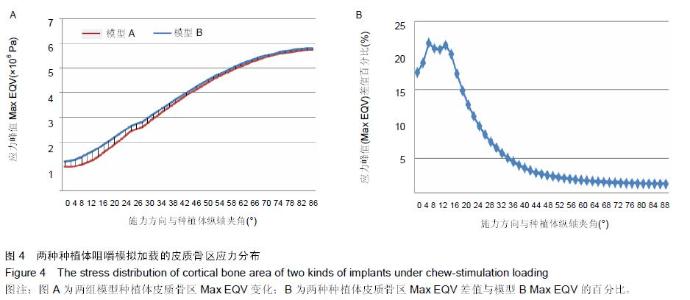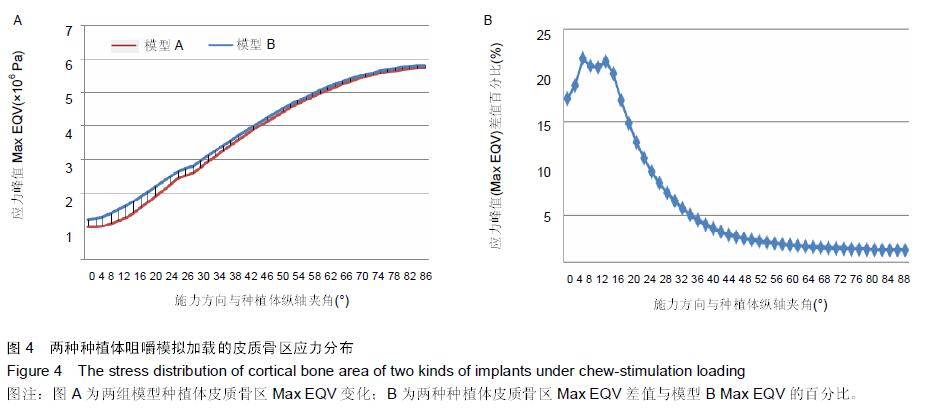Chinese Journal of Tissue Engineering Research ›› 2015, Vol. 19 ›› Issue (47): 7597-7602.doi: 10.3969/j.issn.2095-4344.2015.47.009
Previous Articles Next Articles
Effect of implant structural changes on the cortical bone stress distribution and peak of the implant-bone interface: a three-dimensional finite element analysis
Tong Cheng-hao, Lv Xiao-fei, Peng Cheng
- Department of Stomatology, the Second Hospital of Tianjin Medical University, Tianjin 300211, China
-
Received:2015-09-11Online:2015-11-19Published:2015-11-19 -
Contact:Peng Cheng, Chief physician, Master’s supervisor, Department of Stomatology, the Second Hospital of Tianjin Medical University, Tianjin 300211, China -
About author:Tong Cheng-hao, Studying for master’s degree, Department of Stomatology, the Second Hospital of Tianjin Medical University, Tianjin 300211, China
Cite this article
Tong Cheng-hao, Lv Xiao-fei, Peng Cheng. Effect of implant structural changes on the cortical bone stress distribution and peak of the implant-bone interface: a three-dimensional finite element analysis[J]. Chinese Journal of Tissue Engineering Research, 2015, 19(47): 7597-7602.
share this article
| [1] Kitamura E,Stegaroiu R,Nomura S,et al.BiomechanicaI aspects of marginal bone resorption around osseointegrated implants:considerations based on a three.dimensional finite element analysis.Clin Oral Implants Res. 2004;15(4):401-412. [2] Tada S,Stegaruiu R,Kitamura E,et al.Influenee of implant design and bone quality on stress/strain distribution in bone around implants:a 3-dimensional finite element analysis.Int J Oral Maxillofac Implants. 2003;18(3):357-368.
[3] Abuhussein H, Pagni G, Rebaudi A, et al. The effect of thread pattern upon implant osseointegration. Clin Oral Implants Res. 2010;21(2):129-136.
[4] 陈祖贤,王超,王立军. 上颌后牙区倾斜种植的三维有限元分析[J].中国组织工程研究,2013,17(33): 5957-5962.
[5] 高健,赵守亮,周成杰. 种植体直径-长度比的三维有限元应力分析[J]. 口腔颌面外科杂志,2014,24(5):364-369.
[6] Chen LJ, He H, Li YM, et al. Finite element analysis of stress at implant−bone interface of dental implants with different structures. Trans Nonferrous Met Soc. 2011;21:1602-1610.
[7] 赵静辉,周延民,李春艳. 种植体螺纹位置对应力分布影响的有限元研究[J]. 华西口腔医学杂志,2008,26(6):584-587.
[8] Kitamura E,Stegaroiu R,Nomura S,et al. Influence of marginal bone resorption on stress around an implant-a three-dimensional finite element analysis. J Oral Rehabil. 2005;32(4):279-286.
[9] Holmes DC,Diaz-Arnold AM,Leary JM. Influence of post dimension on stress distribution in dentin. J Prosthet Dent. 1996;75(2):140-147.
[10] Rho JY,Ashman RB,Turner CH. Young’s modulus of trabecular and cortical bone material: ultrasonic and microtensile measurements. J Biomech. 1993;26(2):111-119.
[11] 张强,李英. Ⅱ类骨质中平台转换种植体植入深度对周围骨应力影响的有限元分析[J]. 国际口腔医学杂志,2014,41(1): 31-35.
[12] 李英,焦艳军,张强,等. Ⅳ类骨质中平台转换种植体植入深度对周围骨应力的影响[J]. 现代口腔医学杂志,2014,28(4):218-221.
[13] 张嘉宇.Ⅰ、Ⅲ类下颌骨不同颊舌向骨量种植体有限元分析[D].新疆医科大学,2013.
[14] 夏琳,张志宏,刘红红,等.倾斜种植应用于不同质量颌骨的三维有限元分析[J].安徽医科大学学报,2015,50(5):695-698.
[15] 刘川.圆柱形、颈部锥度、末端锥度及膨胀式种植体生物力学比较的三维有限元分析[D].第四军医大学,2012.
[16] Bahrami B, Shahrbaf S, Mirzakouchaki B, et al. Effect of surface treatment on stress distribution in immediately loaded dental implants-A 3D finite element analysis. Dent Mater. 2014; 30(4): e89-e97.
[17] Ferreira MB, Barão VA, Faverani LP, et al. The role of superstructure material on the stress distribution in mandibular full-arch implant-supported fixed dentures. A CT-based 3D-FEA. Mater Sci Eng C Mater Biol Appl. 2014;35: 92-99.
[18] 戴东晓,李伟,于静,等.种植体修复上部义齿不同面形态设计的三维有限元分析[J].河北医药,2012,34(9):1365-1366.
[19] 符策广,李智勇,王敏,等.骨吸收对平台转换种植体周围骨组织内部应力的影响[J].口腔医学研究,2012,28(9):872-874,879.
[20] 李恺,辛海涛,赵艳芳,等.种植体数目与分布对下颌种植覆盖义齿骨组织应力变化的影响[J].临床口腔医学杂志,2013,29(11): 643-645.
[21] 江鹭鹭.牙种植体生物力学研究进展[J].中国实用口腔科杂志, 2012,5(4):240-244.
[22] 樊文有,卢军,曹斌,等. 含牙种植体下颌骨三维有限元模型的建立[J].口腔颌面外科杂志, 2005,15(1):39-32.
[23] 赖红昌,熊焕国.不同长度种植体对骨界面应力影响的三维有限元分析[J].上海口腔医学,1997,6(1):20-22.
[24] 康宁,宫苹,李娟娟,等. 8 mm 种植体骨内应力分布的三维有限元研究[J].中华口腔医学研究杂志:电子版,2012,6(1):1-8.
[25] 谢蕾,袁小平,黄跃,等.种植体不同植入角度及不同骨皮质厚度对其稳定性影响的三维有限元分析[J].泸州医学院学报, 2012, 35(2):140-144.
[26] Aho AJ, Ekfors T, Dean PB, et al. Incorporation and clinicalresults of large allografts of the extremities and pelvis. Clin Orthop. 1994;(307):200.
[27] Smith EL,Gilligan C. Dose-response relationship between physical loading and mechanical competence of bone. Bone. 1996;18:455.
[28] Atwood DA. Bone loss of edentulous alveolar bone ridges. J Periodontol. 1979;50:11.
[29] Rieger MR, Adams WK, Kinzel GL. A finite element survey of eleven endosseous implants. J Prosthet Dent 1990;63(4): 457-465.
[30] 戴敬哲,单丽华,李晨曦,等.光滑柱状颈部构型的微型种植体-骨界面应力分布的三维有限元分析[J].口腔医学研究,2012,28(8):利时772-774.
[31] 牛金磊,陈建宇,陈贤帅,等. 种植体颈部微螺纹结构对种植稳定性影响的三维有限元分析[J]. 口腔颌面修复学杂志,2013,15(6): 344-348.
[32] 李翠,郭新程,韦艺,等.应用三维有限元法对不同骨质牙种植修复体生物力学的研究[J].口腔颌面外科杂志,2011,21(1):15-18.
[33] 张春秋,吴丹凯,郭玉香,等.骨的疲劳损伤和修复[J].生物医学工程学杂志,2003,20(1):180-186.
[34] 韩丽会,邱晓霞,邢旭娜,等.上颌前牙区种植方案中角度设计的三维有限元分析[J].上海口腔医学,2015,24(2):157-163.
[35] 戴敬哲,单丽华,李晨曦,等. 光滑柱状颈部构型的微型种植体——骨界面应力分布的三维有限元分析[J].口腔医学研究,2012, 8(28):779.
[36] 孙健,熊耀阳,李元超,等.功能梯度牙种植体三维有限元力学分析与结构优化[J].中国组织工程研究与临床康复,2011,15(48): 8960-8963.
[37] Sadollah A, Bahreininejad A.Optimum gradient material for a functionally graded dental implant using metaheuristic algorithms.J Mech Behav Biomed Mater. 2011;4(7): 1384-1395.
[38] 于长洋,李俊源, 彭伟,等.种植义齿缓冲单元材料特性对缓冲效果的影响[J].中国口腔种植学杂志,2014,19(1):18-21.
[39] 陈少武,肖微, 李智勇,等. 种植体上部不同结构对下颌游离端义齿应力分布的影响[J].实用口腔医学杂志, 2012, 28(3):294-297.
[40] 张丽,韩凉,鲁海鑫, 等.舌向集中牙合全口义齿在牙槽嵴重度吸收患者的临床修复效果观察[J].中华老年口腔医学杂志,2012, 10(3): 171-174.
|
| [1] | Xu Feng, Kang Hui, Wei Tanjun, Xi Jintao. Biomechanical analysis of different fixation methods of pedicle screws for thoracolumbar fracture [J]. Chinese Journal of Tissue Engineering Research, 2021, 25(9): 1313-1317. |
| [2] | Zhang Tongtong, Wang Zhonghua, Wen Jie, Song Yuxin, Liu Lin. Application of three-dimensional printing model in surgical resection and reconstruction of cervical tumor [J]. Chinese Journal of Tissue Engineering Research, 2021, 25(9): 1335-1339. |
| [3] | Chen Xinmin, Li Wenbiao, Xiong Kaikai, Xiong Xiaoyan, Zheng Liqin, Li Musheng, Zheng Yongze, Lin Ziling. Type A3.3 femoral intertrochanteric fracture with augmented proximal femoral nail anti-rotation in the elderly: finite element analysis of the optimal amount of bone cement [J]. Chinese Journal of Tissue Engineering Research, 2021, 25(9): 1404-1409. |
| [4] | Zhou Jihui, Li Xinzhi, Zhou You, Huang Wei, Chen Wenyao. Multiple problems in the selection of implants for patellar fracture [J]. Chinese Journal of Tissue Engineering Research, 2021, 25(9): 1440-1445. |
| [5] | Zeng Yanhua, Hao Yanlei. In vitro culture and purification of Schwann cells: a systematic review [J]. Chinese Journal of Tissue Engineering Research, 2021, 25(7): 1135-1141. |
| [6] | Xu Yulin, Shen Shi, Zhuo Naiqiang, Yang Huilin, Yang Chao, Li Yang, Zhao Heng, Zhao Lu. Biomechanical comparison of three different plate fixation methods for acetabular posterior column fractures in standing and sitting positions [J]. Chinese Journal of Tissue Engineering Research, 2021, 25(6): 826-830. |
| [7] | Cai Qunbin, Zou Xia, Hu Jiantao, Chen Xinmin, Zheng Liqin, Huang Peizhen, Lin Ziling, Jiang Ziwei. Relationship between tip-apex distance and stability of intertrochanteric femoral fractures with proximal femoral anti-rotation nail: a finite element analysis [J]. Chinese Journal of Tissue Engineering Research, 2021, 25(6): 831-836. |
| [8] | Song Chengjie, Chang Hengrui, Shi Mingxin, Meng Xianzhong. Research progress in biomechanical stability of lateral lumbar interbody fusion [J]. Chinese Journal of Tissue Engineering Research, 2021, 25(6): 923-928. |
| [9] | Liu Zhao, Xu Xilin, Shen Yiwei, Zhang Xiaofeng, Lü Hang, Zhao Jun, Wang Zhengchun, Liu Xuzhuo, Wang Haitao. Guiding role and prospect of staging and classification combined collapse prediction method for osteonecrosis of femoral head [J]. Chinese Journal of Tissue Engineering Research, 2021, 25(6): 929-934. |
| [10] | Xie Chongxin, Zhang Lei. Comparison of knee degeneration after anterior cruciate ligament reconstruction with or without remnant preservation [J]. Chinese Journal of Tissue Engineering Research, 2021, 25(5): 735-740. |
| [11] | Xu Dongzi, Zhang Ting, Ouyang Zhaolian. The global competitive situation of cardiac tissue engineering based on patent analysis [J]. Chinese Journal of Tissue Engineering Research, 2021, 25(5): 807-812. |
| [12] | Wu Zijian, Hu Zhaoduan, Xie Youqiong, Wang Feng, Li Jia, Li Bocun, Cai Guowei, Peng Rui. Three-dimensional printing technology and bone tissue engineering research: literature metrology and visual analysis of research hotspots [J]. Chinese Journal of Tissue Engineering Research, 2021, 25(4): 564-569. |
| [13] | Chang Wenliao, Zhao Jie, Sun Xiaoliang, Wang Kun, Wu Guofeng, Zhou Jian, Li Shuxiang, Sun Han. Material selection, theoretical design and biomimetic function of artificial periosteum [J]. Chinese Journal of Tissue Engineering Research, 2021, 25(4): 600-606. |
| [14] | Liu Fei, Cui Yutao, Liu He. Advantages and problems of local antibiotic delivery system in the treatment of osteomyelitis [J]. Chinese Journal of Tissue Engineering Research, 2021, 25(4): 614-620. |
| [15] | Li Xiaozhuang, Duan Hao, Wang Weizhou, Tang Zhihong, Wang Yanghao, He Fei. Application of bone tissue engineering materials in the treatment of bone defect diseases in vivo [J]. Chinese Journal of Tissue Engineering Research, 2021, 25(4): 626-631. |
| Viewed | ||||||
|
Full text |
|
|||||
|
Abstract |
|
|||||







